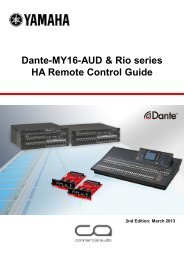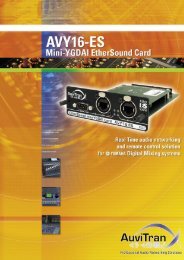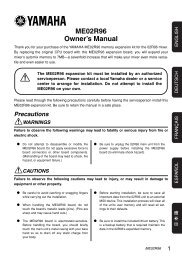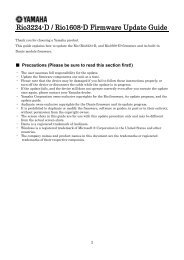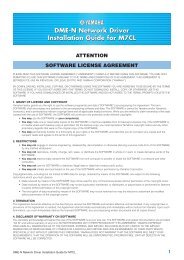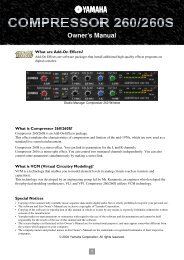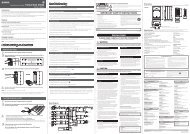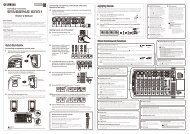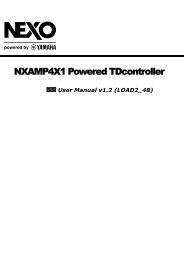Yamaha Digital Audio System Design Guide 8.42MB
Yamaha Digital Audio System Design Guide 8.42MB
Yamaha Digital Audio System Design Guide 8.42MB
Create successful ePaper yourself
Turn your PDF publications into a flip-book with our unique Google optimized e-Paper software.
23<br />
CobraNet CobraNet<br />
Mid-size Live SR<br />
This section describes a typical confi guration for a mid-sized, fully-redundant sound reinforcement system for live music with 32 input and<br />
16 output channels. From the switch set up on the stage, two pairs of CAT5e cables are each connected to the PRIMARY and SECONDARY<br />
connectors on two rack-mounted NHB32-C units on the left and right of the stage. Redundant network system is completed by similarly<br />
connecting a pair of CAT5e cables as PRIMARY and SECONDARY cables to the NHB32-C located at FOH.<br />
In the realm of sound reinforcement, digital cabling is convenient, highly practical, and offer many advantages over traditional analog cabling<br />
in terms of time and money.<br />
The console and the NHB32-C unit could also be connected using a D-sub 9-pin cross cable to facilitate transfer of HA Remote control signals<br />
over the network. In this way, AD8HR units used as mic preamps can be remotely controlled from the console.<br />
E<br />
Equipment List<br />
F.O.H<br />
Manufacturer Equipment Model Qty. Note<br />
A <strong>Yamaha</strong> <strong>Digital</strong> Mixing Console M7CL-32 1<br />
B Network Hub & Bridge NHB32-C 3<br />
C ADC/8ch Remote PreAmp AD8HR 4<br />
D DA Converter DA824 2<br />
E <strong>Digital</strong> I/O Card MY8-AE 2<br />
F <strong>Digital</strong> I/O Card MY16-AE 2<br />
G Speaker Processor SP2060 2<br />
H Switch — 4<br />
<strong>Yamaha</strong> <strong>Digital</strong> <strong>Audio</strong> <strong>System</strong> <strong>Design</strong><br />
B<br />
C<br />
C<br />
D<br />
Mics 17-24<br />
Mics 25-32<br />
F.O.H Console<br />
Mics 1-8<br />
Mics 9-16<br />
To Power Amplifiers,<br />
To Power Amplifiers,<br />
Speaker processor<br />
Speaker processor<br />
G<br />
G<br />
To Power Amp<br />
STAGE<br />
To Power Amp<br />
F<br />
F<br />
A<br />
E<br />
B<br />
H<br />
B<br />
C<br />
C<br />
D<br />
Cat5e cable (Primary)<br />
Cat5e cable (Secondary)<br />
D-sub 25-pin (male) cable<br />
HA Remote (D-sub 9-pin)<br />
Analog<br />
Banquet<br />
This section describes a typical design for a partitionable sound-reinforcement system in a large venue such as a banquet hall, which is divided<br />
into two or more sections using movable partitions. The basic CobraNet network comprises a number of Ethernet wall connector boxes setup<br />
within the banquet hall and individually connected to a standard Ethernet switch located in a control room. Each of the control racks or the LS9<br />
console can be freely connected to any CobraNet wall connector based on the fl oor plan or the way in which the venue will be partitioned, and<br />
in order to gain even more advantage from partitioning, a pair of DME64N units can be setup in the control room in order to rapidly change the<br />
output routings to speakers. The ICP1 wall control panel makes all of this possible, switching between full speaker output for a full-size event<br />
and selective speaker output of the audio mix from a rack console in a partitioned room. A pair of DME8i-C units setup within the banquet hall<br />
provides preamps for up to 16 microphone inputs, in addition to input signal processors such as compressors, EQs, and gates – all of which<br />
can be controlled from GPI-based CP4SW, CP4SF, and CP1SF wall control panels or equivalent devices. Furthermore, the LS9 console even<br />
lets you remotely control the DME8i-C units’ head amps by transmitting HA Remote signals over the CobraNet network.<br />
Ethernet<br />
Connector<br />
Equipment List<br />
For Main SP<br />
Banquet A<br />
For Main SP<br />
Banquet B<br />
For Main SP<br />
Banquet C<br />
For Ceiling SP<br />
(Hi-Impedance Out)<br />
C<br />
Banquet<br />
Capacity: 100<br />
Mics Wireless Mics<br />
To Power Amp<br />
To Power Amp<br />
Movable Partition Movable Partition<br />
H I<br />
F<br />
Banquet<br />
Capacity: 150<br />
Manufacturer Equipment Model Qty. Note<br />
A <strong>Yamaha</strong> <strong>Digital</strong> Mixing Console LS9-32 1<br />
B <strong>Digital</strong> Mixing Console 01V96VCM 2<br />
C CobraNet Interface Card MY16-CII 4<br />
D <strong>Digital</strong> Mixing Engine DME64N 2<br />
E DA Card MY8-DA96 7<br />
F <strong>Audio</strong> I/O & DSP Expansion Unit DME8i-C 2<br />
G Intelligent Control Panel ICP1 1<br />
H Control Panel CP4SW 1<br />
I Control Panel CP4SF 1<br />
J Control Panel CP1SF 1<br />
K Switch — 3<br />
B<br />
Laptop PC<br />
(DME <strong>Design</strong>er)<br />
K<br />
E<br />
C<br />
K<br />
D<br />
E<br />
D<br />
E E<br />
Mics<br />
F<br />
C<br />
E E E<br />
Mics Wireless Mics<br />
A<br />
C<br />
K<br />
The Room Combiner<br />
Component<br />
The DME Room Combiner<br />
Component makes it easy to<br />
flexibly divide, combine, and<br />
zone spaces as required by<br />
your application.<br />
Control Room<br />
Banquet<br />
Capacity: 100<br />
Mics Wireless Mics<br />
Cat5e cable (Primary)<br />
Cat5e cable (DME-Network)<br />
D-sub 68-pin (male) cable<br />
Analog<br />
GPI<br />
<strong>Yamaha</strong> <strong>Digital</strong> <strong>Audio</strong> <strong>System</strong> <strong>Design</strong> 24<br />
B<br />
J<br />
G



